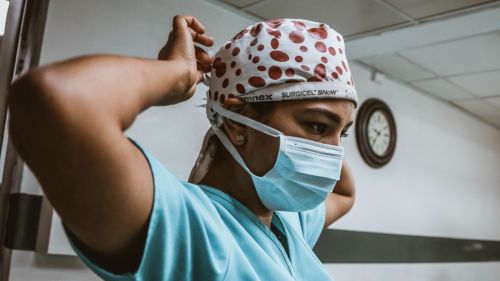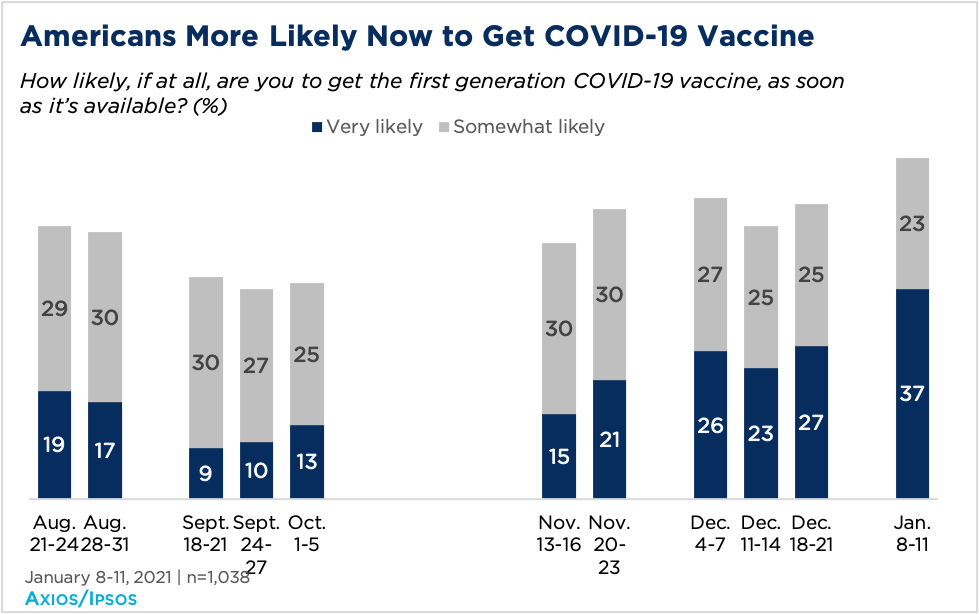Global Public Opinion Shows Hope, Unease at Pandemic

With vaccination efforts under way, some hope that the end of the pandemic is in sight, while others feel uneasy due to distribution issues and immense pressures on the health care system.
This week the world passed the 96.9 million case mark, with over 2 million deaths attributed to COVID-19. As the US death toll passes 400,000, President Joe Biden takes office, and many Americans hope the pandemic will change course under his leadership. At the same time, the coronavirus variant first detected in the United Kingdom quickly spreads across the world, and observers worry that it will cause a massive wave of infections on top of high caseloads in many countries.
The Council survey team is providing updates every other week on public opinion around the world on the COVID-19 pandemic. This week, the Chicago Council Survey team’s update includes polling results from the United States, Japan, South Korea, France, and the United Kingdom.
Key findings
- Although Americans are skeptical that the Biden administration will vaccinate 100 million people by April, 50 percent of Americans say they know someone who has been vaccinated.
- In several of Japan’s prefectures, an emergency declaration on January 7 aimed at stemming the spread of the coronavirus is viewed as coming too late by a majority of Japanese respondents (78%).
- Even as France’s COVID-19 vaccine campaign moves at a slow pace, just 40 percent of French respondents say they would get a COVID-19 vaccine if it were available.
- As the United Kingdom’s National Health Service (NHS) experiences an unprecedented stress from the volume of COVID-19 patients arriving at hospitals, confidence in the organization to handle the crisis is down to 60 percent from 80 percent in May.
- South Korea has secured 106 million doses to cover its population of 56 million, but its goal of reaching herd immunity by November is likely unreachable.
United States
24.4 million cases, 406,190 deaths
President Biden took office yesterday amid a myriad of crises, the most prominent of which is the coronavirus pandemic which continues to kill thousands of Americans each day.
Along with economic policy supports, such as extended unemployment benefits and $1,400 checks sent to households, the “American Rescue Plan” aims to administer 100 million vaccines in the first 100 days of the Biden administration, hire 100,000 public health workers to aid with vaccinations and contact tracing, and expand testing to facilitate school reopening, among numerous other policy objectives.
The administration’s vaccination goal will face added challenges with news this week that the Trump administration was not, in fact, holding additional doses in reserve. Axios/Ipsos polling conducted January 8-11 finds that Americans are somewhat skeptical that the Biden administration will succeed in its goal of vaccinating 100 million Americans by late April, though nearly half of the public thinks it is at least somewhat likely (45%).
One factor not yet holding back progress: public demand for vaccinations. While polls prior to the approval of Pfizer and BioNTech vaccines showed some public hesitation towards getting these vaccines, now that they are here, the public wants a shot. Six in ten Americans (60%) say they are very (37%) or somewhat likely (23%) to get the first-generation COVID-19 vaccine when available; only two in ten (21%) say they are not at all likely to get it when it becomes available. This is a notable increase in enthusiasm for the vaccine since mid-September, when only nine percent of Americans said they were very likely to get a first-generation vaccine.

Now the challenge will be getting vaccine doses to the tens of millions of Americans who urgently want one. So far, the US has administered 14.7 million doses of vaccine, with states focusing on vaccinating health care workers and the elderly. Most Americans don’t expect it will be available for them soon; only nine percent say it is available to them currently. Many are instead preparing for a longer wait, expecting it will be available in the next three months (25%), in the next six months (26%), or longer (22%).
The nationwide campaign to immunize Americans means that already, half of Americans (50%) know someone who has been vaccinated. Three percent of Americans report having been vaccinated themselves; thirteen percent say someone in their immediate family has gotten a vaccine, and 37 percent say they know someone else who has gotten one.
Less happily, most Americans also know someone who has tested positive for the coronavirus (76%), and a third (34%) now know one of the nearly 400,000 Americans who has died as a result. The combinations of Americans personally knowing the costs of the pandemic, and the efficacy of the vaccine, may help continue to boost vaccine adoption rates to the levels needed to end the pandemic emergency.
Japan
343,802 cases, 4,649 deaths
Japan, with Tokyo at its center, remains in the midst of a fresh wave of COVID-19 cases and hospitalizations. NHK polling conducted January 9-11 finds the public split over Prime Minister Suga, with similar proportions backing (40%) and opposing (41%) his Cabinet. The government’s coronavirus response comes in for criticism, with a majority of Japanese (58%) giving the government negative marks.
One key factor in that evaluation is the timing and scope of the state of January 7 emergency declaration, which covered Tokyo as well as the neighboring prefectures of Saitama, Kanagawa, and Chiba. Eight in ten (79%) say the declaration came too late, and most Japanese support an expanded state of emergency, either to other areas (47%) or to the entire country (33%).
In response to this public criticism, as well as requests from prefectural leaders, PM Suga expanded that declaration late last week to cover Osaka, Kyoto, Hyogo, Fukuoka, Aichi, Gifu, and Tochigi. However, unlike the first state of emergency in Japan last April and May, most of the state of emergency is nonbinding, relying on the voluntary cooperation of the populace. Schools, gyms, theaters, and other businesses closed during the first state of emergency will remain open this time around. The state of emergency is scheduled to end on February 7, but the public is skeptical: most Japanese (88%) say that the declaration will not be able to be ended by that date.
Also on the skeptical public’s radar are the upcoming Tokyo Olympics and Paralympics. Already postponed once from their original July 2020 debut, few Japanese (16%) say they should be held on schedule. Instead, similar proportions say the games should be postponed further (39%) or canceled (38%).
Some hope is on the horizon, however, in the form of COVID-19 vaccines. The task of managing the rollout of vaccines in Japan will be taken on by the task of Taro Kono, formerly minister for foreign affairs and defense under Abe and potential future Prime Minister. Assuming the vaccines are approved as scheduled, vaccinations could begin by late February for health care workers, followed by the large population of Japanese over the age of 65. In addition to the logistical hurdles, Kono will also have to win over a public not always eager to embrace vaccines: half of the public (50%) says they want to be vaccinated, while 38 percent currently do not.
South Korea
73,918 cases, 1,316 deaths
South Korea has once again managed to control a COVID-19 outbreak, with daily cases down to 386 on January 18 from a peak of more than 1,200 in late December. Its total number of cases is 73,115. Attention is now turning to government plans to reach herd immunity through vaccination by November. Eventually, everyone in Korea—including foreign residents—will receive the vaccine free of charge. But reaching herd immunity will require more than 30 million people to be vaccinated by September. To put that in perspective, estimates suggest it would require 4,000 doctors and 400,000 people to be vaccinated every day. That timeline likely not reachable, given the current government preparations.
The Moon administration has come under criticism for the delay in securing vaccine doses, but the country now has 106 million doses to cover its population of 56 million. But this criticism has yet to affect President Moon’s job approval. While his approval sits at 38 percent—one of the lowest recordings for his time in office—a plurality (36%) cite his handling of COVID-19 as the primary reason for their approval. Instead, the major drag on his approval comes from the ongoing controversy surrounding real estate prices.
France
2.9 million cases, 71,652 deaths
Although cases remain lower than the spikes in October and November, daily new infections early this week were higher than they have been for a month and a half. Newly rising cases, as well as fears about the more transmissible “UK variant,” have led the government to impose a nation-wide 6 p.m. curfew. This measure is likely intended to avoid a third national lockdown shortly after coming out of their second national lockdown in December.
Beyond the potential for a subsequent devastating wave of the virus, another issue facing France is the pace of the vaccine rollout, as well as the public willingness to take the vaccine. France continues to lag far behind the United Kingdom and the United States in the number of vaccines administered to French people. In Europe, France is nearly last in the doses given per 100,000 people.
A large part of the reason for this slow pace is the public perception of the vaccine. An Ipsos/World Economic Forum poll from December 17-20 found that just 40 percent of French respondents say they would get a COVID-19 vaccine if it were available. This is a 14 percentage-point drop from when this question was first asked in October. However, although the proportion of French people willing to get a vaccine is low, nearly two-thirds of French people (63%) say that the lag in vaccination in France is worrying. And, a slight majority says that France will not be able to catch up soon (53%), according to a January 13-14 Odoxa poll.
Anti-vaccination sentiment is driven, in part, by distrust for the government and Macron, who faces an approval rating of 40 percent based on an Odoxa poll from January 13-14. Jean Castex, the Prime Minister, faces an even worse approval rating at 35 percent. Moreover, concerning the vaccination campaign, French people say that the actions of the government are not coherent (70%), do not inspire confidence (70%), are not effective (73%), and are unclear (76%).
The United Kingdom
3.5 million cases, 93,290 deaths
England, Scotland, Wales, and Northern Ireland are all in lockdown, though each of their specific lockdown rules are set to expire at different times. Although cases remain very high relative to early December when the United Kingdom was between lockdowns, the seven-day average of new cases is dropping rapidly. Nonetheless, an Ipsos MORI survey from January 8-11 found that a plurality of Britons think that the current coronavirus measures are not strict enough (48%) while 37 percent say they are about right. Even still, 78 percent of UK respondents say they are following the restrictions completely or nearly all of the time.
Nonetheless, as cases remain high, the National Health Service (NHS) is buckling under the pressure of caring for the continuing influx of patients. Chief executive of the NHS, Simon Stevens, says that the organization is facing its “most precarious position in its history.” At the same time, an Ipsos MORI survey finds that confidence in the NHS to deal with the coronavirus is dropping. As of January 8-11, 60 percent of Britons say that they are confident in the NHS to deal with this crisis; however, this is the lowest proportion of UK residents who say so since the pandemic took off in March. In May, confidence in the NHS was at around 80 percent.
Coupled with this diminishing confidence is a growing sense of danger among UK citizens. Asked if they would feel safe going outside their home at all, 56 percent of British respondents say that they would feel safe, the lowest proportion since this question was first asked in July, according to a January 11 Redfield and Wilton survey. By comparison, 80 percent said they felt safe going outside their home when asked the same question in October. Similarly, the lowest proportion of British respondents say they feel safe eating inside (16%) or outside (25%) a restaurant or pub, going to work (38%), going food shopping (48%), or using public transport (18%) since these questions were first asked earlier in the year.





